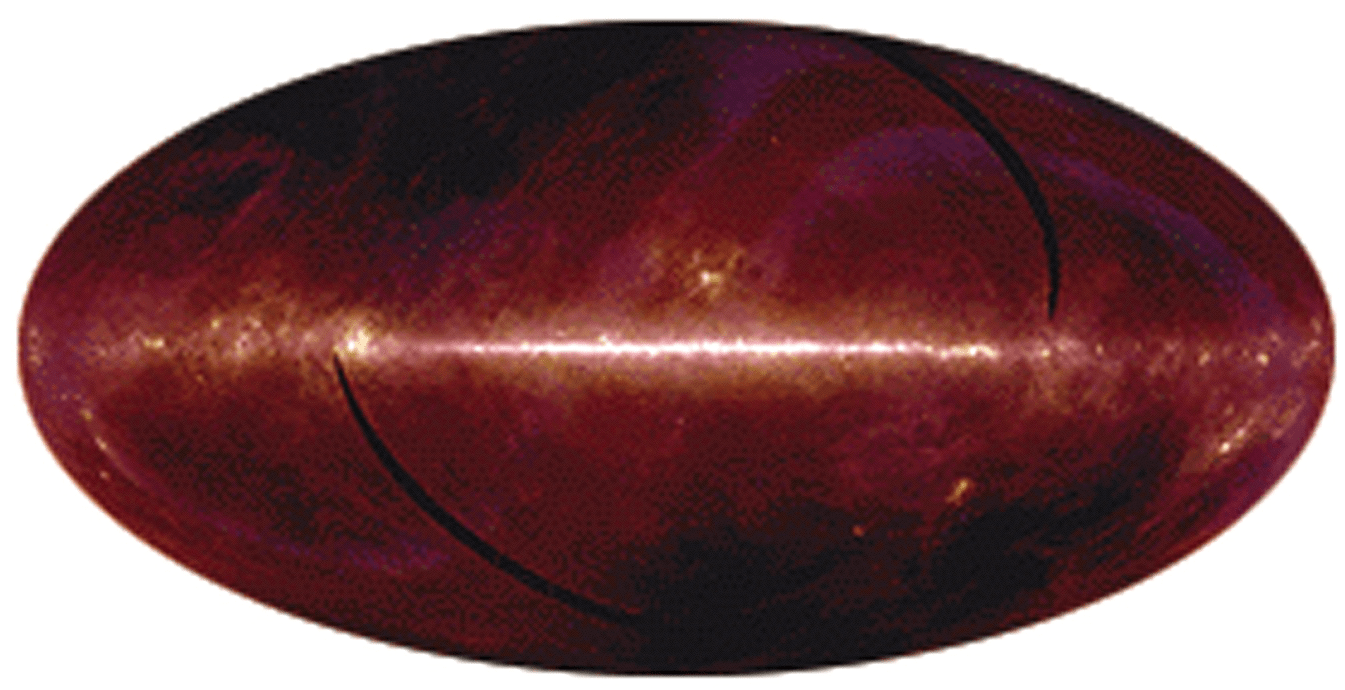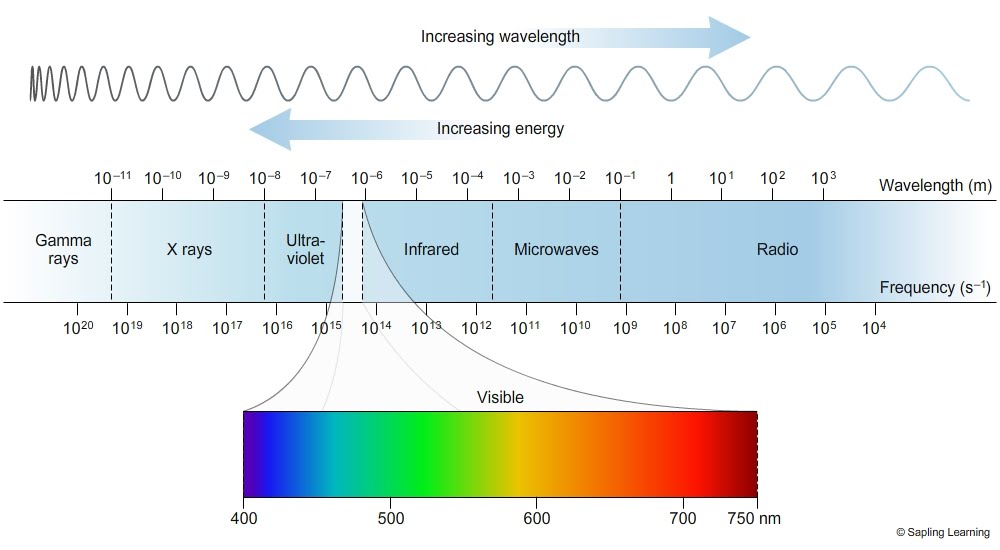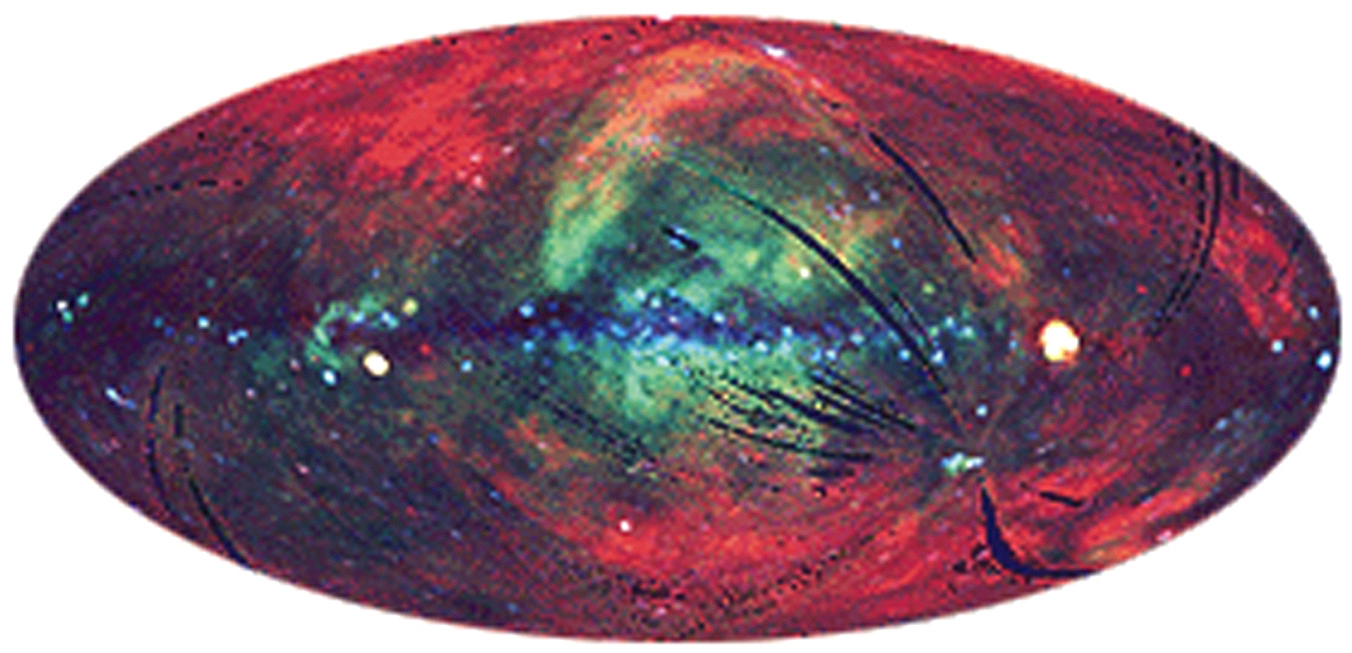
Does this sight look familiar?
If you’ve had the opportunity to observe the night sky from a dark place, far away from the light pollution of the city, on a clear night, you might have seen this before. It’s the Milky Way—our view of our galaxy from the inside.
It’s kind of like if you lived inside a frisbee. Look up toward the flat sides, and there’s not as much material to look through. But peer out at the edges of the disk, and you have to look through a lot more stars.
Most of the stars you see in the night sky are part of the Milky Way. But this is the sight we get when we stare through to the center of the frisbee.
Thing is, though, this is far from the most spectacular sight of the night sky.

Now here’s something you’re less likely to have seen. Believe it or not, this is an image of the exact same area of the sky as above—except it’s what the galaxy would look like if our eyes could see in the infrared.
In case you missed (or don’t remember) my posts on the electromagnetic spectrum, infrared is just a form of radiation—not unlike visible light. In fact, the Hubble Telescope can see in the infrared.

Infrared radiation is defined as having a “wavelength” just a bit longer than visible light. And it’s something you’re familiar with from your daily life, even if you don’t recognize its name—it’s responsible for heat.
By the way, fun fact, infrared radiation doesn’t cause sunburns.
You might think that it should, because it’s heat and heat burns. But normal burns—first, second, third degree—are indeed caused by infrared radiation. That’s different, though. You can feel heat before it burns you.
Why? Because the feeling of heat is just your touch receptors translating the wavelengths of radiation bombarding you in a way your brain can understand. Vibrations of the right pitch translate as sound, and radiation of the right wavelength translates as light, or heat.
But if that radiation has too high a pitch—that is, too short a wavelength—to be translated at all, you can’t register it, and you don’t feel it as heat. It’s why you don’t feel the sun burning you until it’s too late.
That’s the danger of ultraviolet radiation, which does cause sunburns. Because its shorter wavelength means it carries just enough energy to burn you, but is just short enough that you can’t feel it.
Anyway…enough on the quirks of the electromagnetic spectrum. How about we take another look at that infrared image of the galaxy?

Basically, this is a visual image of heat rolling off the dust particles sprinkled through the galaxy. Most stars emit less infrared radiation than visible light or shorter wavelengths, so they don’t appear as bright as you’re used to.
But, you ask, if heat and light are simply our visual and touch receptors’ way of translating information for our brains, how can we have a visual image of heat?
Because this image isn’t showing literal color. It’s a color coded image—with brighter colors indicating hotter infrared radiation, and redder colors indicating cooler infrared radiation.
Now you can kind of see what this image is telling you. The stars aren’t quite as bright when we’re just looking at the infrared, but they’re still a good deal brighter than the surrounding…stuff.
What “stuff” could that possibly be?
It’s dust. Great big clouds of interstellar dust, each grain emitting a teeny, tiny bit of infrared radiation…but whole clouds of them shine bright.
Not as bright as the stars, obviously. But we can see them. Tune into the infrared part of the spectrum, and the whole galaxy glows with interstellar dust.
So how the heck can they be that bright…when they’re really not emitting that much energy at all?
The secret lies with their surface area.
Let me give you an example of how this works for stars. Take a look at the H-R diagram, a graph plotting basically every type of star there is according to its luminosity—the total radiation it emits—and its temperature.

This H-R diagram has stars illustrated pretty accurately according to size. The scale is a bit off—the biggest stars are tens of thousands of times bigger than the smallest stars, instead of just a few millimeters—but I think you can get the idea.
Anyway, see Betelgeuse up there in the top right? It’s one of the supergiants. And a unifying characteristic of supergiant stars is that they’re really cool.
Well, temperature-wise, I mean. But they’re pretty awesome, too.
Anyway, supergiants aren’t the only cool stars out there. Red dwarfs are actually around the same temperature—just a bit cooler than the supergiants. (Those are the tiny red stars disappearing off to the bottom right.)
Red dwarfs and supergiants are pretty close in temperature. But they differ vastly in luminosity…because supergiants are tens of thousands of times bigger.
See, left to its own devices, temperature would make supergiants just as faint in the sky as red dwarfs. But thankfully for us, brightness also depends on surface area.
You can think of a single red dwarf as like a light bulb. You know how light bulbs get hot to the touch if they’re left on for a while? Well, imagine walking into a room lit up with ten or more light bulbs.

Touch any one of them, and it’s only as hot as one of them. But twenty light bulbs light up a room much better than one.
The same goes for stars…and for dust.
Interstellar dust—the stuff between the stars—doesn’t emit a whole lot of infrared radiation at all. But there’s tons of it. It’s like the whole galaxy is a giant sandbox of interstellar dust, with stars scattered about here and there.
And what does that mean?
Imagine if you went to the beach, and every grain of sand was glowing. Just a little, just faintly.
There are some lanterns scattered along the coast, and they’re shining much brighter. But every single grain of sand is aglow with infrared radiation, and as a whole, it makes the beach glow much brighter than you would expect for its temperature.
Here’s the somewhat strange thing, though. The interstellar medium is also very luminous at x-ray wavelengths…though x-rays carry much more energy than visible light. In fact, they carry more energy even than ultraviolet rays.

Based on everything we know about the low temperature of these dust grains and their luminosity due to surface area, they shouldn’t emit x-rays. And yet they do. At x-ray wavelengths, the galaxy is aglow with interstellar dust.
But that just means there’s more to learn, more to discover one day. The interstellar medium—and the intergalactic medium, the not-quite-so-empty space between galaxies—are two of the greatest mysteries left in astronomy.
In my next few posts, I’ll take you on a few other tours of the parts of the interstellar medium, and we’ll take an up-close look at what these mysterious dust grains are like.
The naked eye view of the Milky Way in a dark sky stirs our senses and prompts us to consider our place in the galaxy. With the growth of city life and increasing light pollution, less people are able (or even inclined) to experience the richness and beauty of our galaxy.
Thank you, Emma, for another great post!
LikeLiked by 1 person
Glad you enjoyed! Indeed—it always surprises me when I point out the Milky Way during a dark sky event, and people gasp and cover their mouths as if they’ve never seen it before in their life. Which they probably haven’t. I should be used to that by now, but I hope it never seems normal to me. It’s saddening.
LikeLiked by 1 person